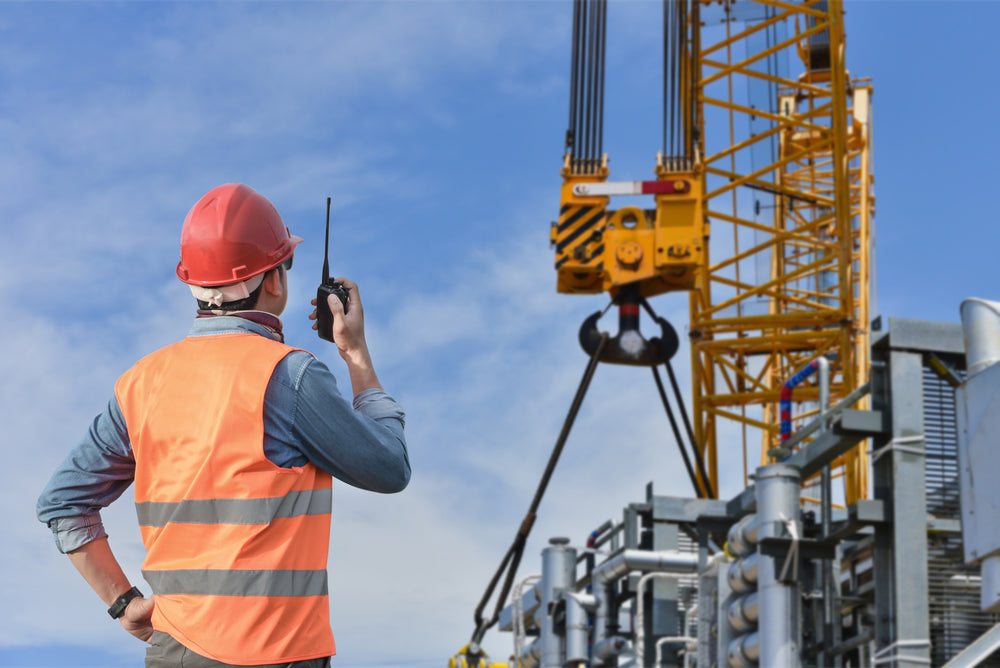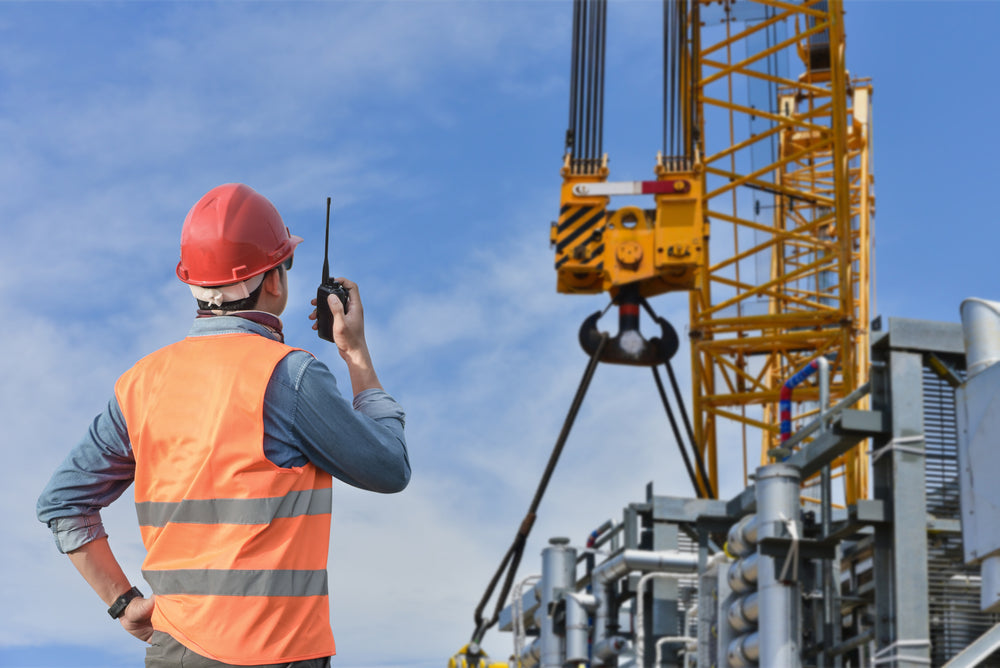TLILIC0023 Licence to Operate a Slewing Mobile Crane (up to 60 tonnes) Training Course - Ingleburn, Sydney

TLILIC0023 Licence to Operate a Slewing Mobile Crane (up to 60 tonnes) Training Course - Ingleburn, Sydney
Out of stock
Welcome to the TLILIC0023 training course for a license to operate a mobile slewing crane (upto 60 tonnes). This course allows you to apply for the C6 high-risk work licence after successfully completing it.
This NSW-based course specifies the knowledge and skills required to safely operate an slewing mobile cran with a maximum rated capacity (MRC) of up to 60 tons in accordance with relevant legislative responsibilities.
The competence in this unit does not automatically result in a High Risk Work Licence to operate this plant.
Slewing mobile crane is a mobile crane with a boom or jib which can be slewed. It does not include the following:
-
Front-end loader
-
A backhoe is a machine that can be used to dig up or
-
An excavator, or
-
Other earth moving equipment configured for crane operation.
This work requires a person to be able to operate a mobile slewing crane with MRC of up to 60 tonnes HRWL.
This unit requires a crane operator to operate a slewing-mobile crane with a MRC of up to 60 tonnes:
-
Plan the work/task.
-
Prepare for the task/work.
-
Perform work/task.
-
Pack up.
This unit of competency is subject to legislative and regulatory requirements.
This unit is based upon the licensing requirements in Part 4.5 of Model Work Health and Safety Regulations (WHS). It meets Commonwealth, State and Territory HRWL requirements.
The National Assessment Instrument is the mandatory assessment for HRWL to operate in the relevant licensing class, as detailed in this unit.
The OHS.com.au & Kallibr Training Advantage
- Quality training – our sites replicate real-world construction sites and our clients find that highly valuable.
- Convenience - we run an extensive public course schedule and can also do private courses at your worksite.
- Experience - our trainers are from industry and have typically have decades of practical experience which is critical for high risk work environments
Where will the course be held in Sydney?
Training Provider: Kallibr Training (RTO 32365)
Location: Onsite training (Face to face)
Course length: 35 hours (Approx. 5 Days (4 days training plus 1 day assessment)
Certification / Accreditation: Nationally Recognised Statement of Attainment
Prerequisite: Nil but you will also need a white card to enter a work site
Kallibr Training is operating from Sydney's largest construction training centre.
It is a licenced, insured and accredited RTO (32365). All the instructors have completed their Certificate IV in Training and Assessment and are highly experienced, vocational trainers.
This fully equipped facility is designed to provide the highest quality training. The training facility is located in Ingleburn, offering a large array of equipment, structures and plant for construction, high-risk training, and access.
The Kallibr Training Centre is located at 3a Williamson Rd, Ingleburn NSW 2565
B
Background: How Can Regular Maintenance Increase The Lifespan of Your Slewing Mobile crane?
If you neglect to maintain your mobile crane, it can cost you a lot of money in repairs and reduce its lifespan.
Implementing a structured maintenance program will ensure that your crane continues to operate efficiently and safely for many years.
It is important that you are familiar with the key components of your mobile crane.
These include the booms, counterweights and slewing rings, as well as the hydraulic system and control system.
Each component is crucial to the overall safety and functionality of the crane.
The boom is used to lift and lower heavy loads while the counterweights are responsible for stability.
The hydraulic system powers the crane movements.
The control system allows operators to operate the crane with precision, safety and ease.
The lifespan and performance of your mobile crane slewing can be significantly affected by the maintenance of its components.
Regular inspections, maintenance, and repairs will help to prevent wear and tear and ensure that the crane continues to operate smoothly and efficiently for many years.
Monthly Maintenance Tasks
-
Inspection of structural components for signs or damage or fatigue.
-
Lubrication is used to reduce friction and wear on moving parts, such as bearings and gears.
-
Test and calibrate safety features, such as limit switches and overload protection systems.
-
Checking and tightening bolts and nuts to ensure structural integrity.
-
Examine electrical systems, including wiring, connections and controls, for any abnormalities or issues.
Annual Maintenance Tasks
-
Examine the entire crane structure including the boom, the jib and the mast for any cracks or corrosion.
-
Inspection of wire ropes and cables for wear, corrosion or damage and replacement if necessary.
-
Hydraulic systems are evaluated for leaks, fluid levels and functionality.
-
Test load cells and other load measuring devices for accuracy and reliability.
-
Review and update maintenance records and documentation in order to track the crane’s maintenance history, and ensure compliance with regulatory requirements.
License requirement for mobile cranes that slew in NSW
You will need to apply in NSW for the appropriate high-risk work license class.
These licenses are:
20-tonne capacity – C2 high-risk work licence
The class of work is an operator of a mobile slewing crane with a maximum capacity of 20 tonnes.
This licence also includes the authority to operate:
-
Non-slewing mobile Crane - CN.
-
Vehicle loading crane (CV) (excluding the application load estimation and slinging technique).
-
reach stacker - RS.
60-tonne capacity – C6 high-risk work licence
The class of work involves the operation of a mobile slewing crane with a maximum capacity of 60 tonnes.
This licence includes authority to operate a mobile slewing crane with a maximum capacity of:
-
20 tonnes or less C2.
-
Non-slewing mobile Crane - CN.
-
Vehicle loading crane (CV) (excluding the application load estimation and slinging technique).
-
reach stacker - RS.
100-tonne capacity – C1 high-risk work licence
The class of work involves the operation of a mobile slewing crane with a maximum capacity of 100 tonnes.
This licence includes the authority to operate slewing mobile cranes with a maximum capacity of:
-
60 tonnes or less C6.
-
20 tonnes or less C2.
-
Non-slewing mobile Crane - CN.
-
Vehicle loading crane (CV) (excluding the application load estimation and slinging technique).
-
reach stacker - RS.
Capacity greater than 100 tonnes - C0 High Risk Work Licence
The class of work is that of operator of a mobile crane with a capacity greater than 100 tonnes.
This licence includes authority to operate a mobile slewing crane with a maximum capacity of:
-
100 tonnes or less (C1)
-
60 tonnes or less C6.
-
20 tonnes or less C2.
-
Non-slewing mobile Crane - CN.
-
Vehicle loading crane (CV) (excluding the application load estimation and slinging technique).
-
reach stacker - RS.
Operator Competency and Licensing
A person must have a High Risk Work (HRW) license to operate a vehicle-loading crane with a capacity greater than 10 metre tons.
This can be:
Vehicle Loading Crane Licence, or one of four slewing crane HRW licenses (Slewing Mobile Crane with a capacity between 20 and 60 tonnes; slewing Mobile Crane with a capacity between 100 and 200 tonnes; slewing Mobile Crane with a capacity above 100 tonnes).
A crane has 10 metre tonnes of capacity if, at any point on its load chart, the radius in metres multiplied by load (in tons) is equal or greater than 10.
A person who holds a HRW licence for a vehicle-loading crane is able to use load estimation and slinging methods when operating a VLC in normal circumstances.
NSW requires a licensed dogger if:
-
The VLC is used to position loads at elevated or remote locations.
-
The operator operates the crane with a licence for a mobile slewing crane.
What will you learn from ?
-
Work orders or equivalents are used to identify the task requirements. A lift plan is confirmed by associated personnel, and a site visit is conducted according to workplace procedures.
-
The mobile crane's Rated Capacity (RC), and the lifting equipment's Working Load Limits (WLL), are determined and are suitable for the loads and work/tasks required in accordance with the manufacturer requirements and workplace procedures.
-
Implementation of the traffic management plan is confirmed according to workplace procedures.
-
In accordance with workplace procedure, the appropriate communication procedures are identified to all associated personnel.
-
The lift plan and safe working procedures are used to check the implementation of risk control measures.
-
The mobile crane is operated safely according to the manufacturer's requirements and safe working procedures.
-
Set up counterweights as needed in accordance with lift plan, manufacturer requirements and safe working procedures.
-
The fly jib or luffing flies are set up according to the manufacturer's specifications and safe working procedures.
-
The manufacturer's requirements and safe working procedures are followed.
-
The logbook for the crane is checked to ensure that it is in compliance with current regulations, is complete and signed, and any required rectifications are signed off according to manufacturer requirements and safe working procedures.
-
The boom/jib, and hook block should be positioned safely over the load in accordance with the lift plans and safe work procedures.
-
The main and/or auxiliary lifting hook, as well as any other lifting gear, if required, is connected to the load. It is then used in a safe manner, according to the lift plan, the safe work procedures, and the manufacturer's requirements.
-
The crane boom/jib and lifting gear, as well as any other equipment required for safe work, are stowed away and secured in accordance with the manufacturer's requirements.
-
The crane fly jib, luffing flies and counterweights are moved to a storage position. They are then secured in accordance with the manufacturer's requirements and safe working procedures.
-
As per the manufacturer's requirements and safe working procedures, apply the relevant motion locks and brakes.
-
Outriggers, plates or packing are stowed in accordance with the manufacturer's requirements and safe working procedures.
Upon successful completion of this course, student will be awarded a Statement of Attainment and therefore the ability to apply for a High-Risk Work Licence to Operate a Vehicle Loading Crane by WorkSafe NSW.
Course Outcomes
- Nationally Recognised Statement of Attainment
- Ability to apply for a C6 high risk work licence
- Credit towards a full qualification.
- Continue your education and improve your career prospects with these strong pathways.
Entry requirements
- Reached 18 years of age to sit the SafeWork NSW assessment.
- A general construction induction card (commonly known as a white card).
- Proof of current residential address
- 100 points for identification for the SafeWork assessment.
-
Students will need to have a basic understanding and knowledge of English.
HOW TO APPLY FOR YOUR NEW HIGH RISK LICENCE IN NSW
The application must be submitted within 60 days after the successful completion of the practical assessment.
You can read the rules about applying for a High Risk Work Licence in NSW here.
- Complete your training and be deemed competent
- Complete your application for National Licence to Perform High Risk Work which will be given to you by the RTO and their approved SafeWork NSW Assessor
- You also need your Notice of Satisfactory Assessment (N5 form again provided to you by the RTO approved assessor). This is the original orange and white copy.
- Provide list of 100 points of ID
- A photo (passport quality) with your details written on the back
- Previous licence if you have it
- Go to a participating Australia Post office and apply
- There are fees and charges applicable. See here
You can call SafeWork NSW on 131050 if you have any further questions. Renewals can be done online providing it is not more than 12 months expired.
SKU:
Course Highlights:
- 5 days Face-to-Face
- Expert-Led + Practical
- Quality Focused
- Fast Certification
- Tax Deductable
- Trusted RTO Provider
- Statement of Attainment
- Nationally Recognised
Couldn't load pickup availability

"Well run course! The trainer was very efficient, well prepared, communicated clearly what we would cover and finished on time 👍"
Nathan"Good customer service great knowledge and understanding from the trainers couldn’t recommend a better place to be trained"
Melanie"The course was very informative. Going into the course I didn’t think I’d learn anything new but I was astonished with how much I learnt."
Paul.P"This course was Informative and practical shout out to John for leading the session."
JayADDITIONAL EXTRA BONUSES with OHS.com.au
Claim up to $1271.95 worth of Extra Bonuses
with every purchase
- Your personal copy of Safety Legends E-Book (value $39.95)
- $100 off your first case from Naked Wines (value $100)
- Upto 350,000 Bonus AMEX Frequent Flyer points* (value $1000)
- Complimentary Access to two online courses** (value $132)
$1271.95 EXTRA VALUE - JUST FOR YOU INSIDE!
* New customers when you successfully sign up for a new personal / business credit card ** Indigenous Cultural Awareness / Impacts of Climate Change coursesDescription
Welcome to the TLILIC0023 training course for a license to operate a mobile slewing crane (upto 60 tonnes). This course allows you to apply for the C6 high-risk work licence after successfully completing it.
This NSW-based course specifies the knowledge and skills required to safely operate an slewing mobile cran with a maximum rated capacity (MRC) of up to 60 tons in accordance with relevant legislative responsibilities.
The competence in this unit does not automatically result in a High Risk Work Licence to operate this plant.
Slewing mobile crane is a mobile crane with a boom or jib which can be slewed. It does not include the following:
-
Front-end loader
-
A backhoe is a machine that can be used to dig up or
-
An excavator, or
-
Other earth moving equipment configured for crane operation.
This work requires a person to be able to operate a mobile slewing crane with MRC of up to 60 tonnes HRWL.
This unit requires a crane operator to operate a slewing-mobile crane with a MRC of up to 60 tonnes:
-
Plan the work/task.
-
Prepare for the task/work.
-
Perform work/task.
-
Pack up.
This unit of competency is subject to legislative and regulatory requirements.
This unit is based upon the licensing requirements in Part 4.5 of Model Work Health and Safety Regulations (WHS). It meets Commonwealth, State and Territory HRWL requirements.
The National Assessment Instrument is the mandatory assessment for HRWL to operate in the relevant licensing class, as detailed in this unit.
The OHS.com.au & Kallibr Training Advantage
- Quality training – our sites replicate real-world construction sites and our clients find that highly valuable.
- Convenience - we run an extensive public course schedule and can also do private courses at your worksite.
- Experience - our trainers are from industry and have typically have decades of practical experience which is critical for high risk work environments
Where will the course be held in Sydney?
Training Provider: Kallibr Training (RTO 32365)
Location: Onsite training (Face to face)
Course length: 35 hours (Approx. 5 Days (4 days training plus 1 day assessment)
Certification / Accreditation: Nationally Recognised Statement of Attainment
Prerequisite: Nil but you will also need a white card to enter a work site
Kallibr Training is operating from Sydney's largest construction training centre.
It is a licenced, insured and accredited RTO (32365). All the instructors have completed their Certificate IV in Training and Assessment and are highly experienced, vocational trainers.
This fully equipped facility is designed to provide the highest quality training. The training facility is located in Ingleburn, offering a large array of equipment, structures and plant for construction, high-risk training, and access.
The Kallibr Training Centre is located at 3a Williamson Rd, Ingleburn NSW 2565
B
Background: How Can Regular Maintenance Increase The Lifespan of Your Slewing Mobile crane?
If you neglect to maintain your mobile crane, it can cost you a lot of money in repairs and reduce its lifespan.
Implementing a structured maintenance program will ensure that your crane continues to operate efficiently and safely for many years.
It is important that you are familiar with the key components of your mobile crane.
These include the booms, counterweights and slewing rings, as well as the hydraulic system and control system.
Each component is crucial to the overall safety and functionality of the crane.
The boom is used to lift and lower heavy loads while the counterweights are responsible for stability.
The hydraulic system powers the crane movements.
The control system allows operators to operate the crane with precision, safety and ease.
The lifespan and performance of your mobile crane slewing can be significantly affected by the maintenance of its components.
Regular inspections, maintenance, and repairs will help to prevent wear and tear and ensure that the crane continues to operate smoothly and efficiently for many years.
Monthly Maintenance Tasks
-
Inspection of structural components for signs or damage or fatigue.
-
Lubrication is used to reduce friction and wear on moving parts, such as bearings and gears.
-
Test and calibrate safety features, such as limit switches and overload protection systems.
-
Checking and tightening bolts and nuts to ensure structural integrity.
-
Examine electrical systems, including wiring, connections and controls, for any abnormalities or issues.
Annual Maintenance Tasks
-
Examine the entire crane structure including the boom, the jib and the mast for any cracks or corrosion.
-
Inspection of wire ropes and cables for wear, corrosion or damage and replacement if necessary.
-
Hydraulic systems are evaluated for leaks, fluid levels and functionality.
-
Test load cells and other load measuring devices for accuracy and reliability.
-
Review and update maintenance records and documentation in order to track the crane’s maintenance history, and ensure compliance with regulatory requirements.
License requirement for mobile cranes that slew in NSW
You will need to apply in NSW for the appropriate high-risk work license class.
These licenses are:
20-tonne capacity – C2 high-risk work licence
The class of work is an operator of a mobile slewing crane with a maximum capacity of 20 tonnes.
This licence also includes the authority to operate:
-
Non-slewing mobile Crane - CN.
-
Vehicle loading crane (CV) (excluding the application load estimation and slinging technique).
-
reach stacker - RS.
60-tonne capacity – C6 high-risk work licence
The class of work involves the operation of a mobile slewing crane with a maximum capacity of 60 tonnes.
This licence includes authority to operate a mobile slewing crane with a maximum capacity of:
-
20 tonnes or less C2.
-
Non-slewing mobile Crane - CN.
-
Vehicle loading crane (CV) (excluding the application load estimation and slinging technique).
-
reach stacker - RS.
100-tonne capacity – C1 high-risk work licence
The class of work involves the operation of a mobile slewing crane with a maximum capacity of 100 tonnes.
This licence includes the authority to operate slewing mobile cranes with a maximum capacity of:
-
60 tonnes or less C6.
-
20 tonnes or less C2.
-
Non-slewing mobile Crane - CN.
-
Vehicle loading crane (CV) (excluding the application load estimation and slinging technique).
-
reach stacker - RS.
Capacity greater than 100 tonnes - C0 High Risk Work Licence
The class of work is that of operator of a mobile crane with a capacity greater than 100 tonnes.
This licence includes authority to operate a mobile slewing crane with a maximum capacity of:
-
100 tonnes or less (C1)
-
60 tonnes or less C6.
-
20 tonnes or less C2.
-
Non-slewing mobile Crane - CN.
-
Vehicle loading crane (CV) (excluding the application load estimation and slinging technique).
-
reach stacker - RS.
Operator Competency and Licensing
A person must have a High Risk Work (HRW) license to operate a vehicle-loading crane with a capacity greater than 10 metre tons.
This can be:
Vehicle Loading Crane Licence, or one of four slewing crane HRW licenses (Slewing Mobile Crane with a capacity between 20 and 60 tonnes; slewing Mobile Crane with a capacity between 100 and 200 tonnes; slewing Mobile Crane with a capacity above 100 tonnes).
A crane has 10 metre tonnes of capacity if, at any point on its load chart, the radius in metres multiplied by load (in tons) is equal or greater than 10.
A person who holds a HRW licence for a vehicle-loading crane is able to use load estimation and slinging methods when operating a VLC in normal circumstances.
NSW requires a licensed dogger if:
-
The VLC is used to position loads at elevated or remote locations.
-
The operator operates the crane with a licence for a mobile slewing crane.
What will you learn from ?
-
Work orders or equivalents are used to identify the task requirements. A lift plan is confirmed by associated personnel, and a site visit is conducted according to workplace procedures.
-
The mobile crane's Rated Capacity (RC), and the lifting equipment's Working Load Limits (WLL), are determined and are suitable for the loads and work/tasks required in accordance with the manufacturer requirements and workplace procedures.
-
Implementation of the traffic management plan is confirmed according to workplace procedures.
-
In accordance with workplace procedure, the appropriate communication procedures are identified to all associated personnel.
-
The lift plan and safe working procedures are used to check the implementation of risk control measures.
-
The mobile crane is operated safely according to the manufacturer's requirements and safe working procedures.
-
Set up counterweights as needed in accordance with lift plan, manufacturer requirements and safe working procedures.
-
The fly jib or luffing flies are set up according to the manufacturer's specifications and safe working procedures.
-
The manufacturer's requirements and safe working procedures are followed.
-
The logbook for the crane is checked to ensure that it is in compliance with current regulations, is complete and signed, and any required rectifications are signed off according to manufacturer requirements and safe working procedures.
-
The boom/jib, and hook block should be positioned safely over the load in accordance with the lift plans and safe work procedures.
-
The main and/or auxiliary lifting hook, as well as any other lifting gear, if required, is connected to the load. It is then used in a safe manner, according to the lift plan, the safe work procedures, and the manufacturer's requirements.
-
The crane boom/jib and lifting gear, as well as any other equipment required for safe work, are stowed away and secured in accordance with the manufacturer's requirements.
-
The crane fly jib, luffing flies and counterweights are moved to a storage position. They are then secured in accordance with the manufacturer's requirements and safe working procedures.
-
As per the manufacturer's requirements and safe working procedures, apply the relevant motion locks and brakes.
-
Outriggers, plates or packing are stowed in accordance with the manufacturer's requirements and safe working procedures.
Upon successful completion of this course, student will be awarded a Statement of Attainment and therefore the ability to apply for a High-Risk Work Licence to Operate a Vehicle Loading Crane by WorkSafe NSW.
Course Outcomes
- Nationally Recognised Statement of Attainment
- Ability to apply for a C6 high risk work licence
- Credit towards a full qualification.
- Continue your education and improve your career prospects with these strong pathways.
Entry requirements
- Reached 18 years of age to sit the SafeWork NSW assessment.
- A general construction induction card (commonly known as a white card).
- Proof of current residential address
- 100 points for identification for the SafeWork assessment.
-
Students will need to have a basic understanding and knowledge of English.
HOW TO APPLY FOR YOUR NEW HIGH RISK LICENCE IN NSW
The application must be submitted within 60 days after the successful completion of the practical assessment.
You can read the rules about applying for a High Risk Work Licence in NSW here.
- Complete your training and be deemed competent
- Complete your application for National Licence to Perform High Risk Work which will be given to you by the RTO and their approved SafeWork NSW Assessor
- You also need your Notice of Satisfactory Assessment (N5 form again provided to you by the RTO approved assessor). This is the original orange and white copy.
- Provide list of 100 points of ID
- A photo (passport quality) with your details written on the back
- Previous licence if you have it
- Go to a participating Australia Post office and apply
- There are fees and charges applicable. See here
You can call SafeWork NSW on 131050 if you have any further questions. Renewals can be done online providing it is not more than 12 months expired.
- Money Back Guarantee
- Save Time & Money
- Tax Deductible
- 1000's Trained Each Month
- Quality-Focused
- Peer Reviewed Courses
- Trusted Industry Partner
- Fast Certification
- 60 Day Guarantee
- *See refund policy


Got multiple people needing to do a course? We will get back to you within a day!
Student Reviews

Couldn't load pickup availability

Contact Us!
Contact form
ADDITIONAL EXTRA BONUSES with OHS.com.au
Claim up to $1271.95 worth of Extra Bonuses
with every purchase
- Your personal copy of Safety Legends E-Book (value $39.95)
- $100 off your first case from Naked Wines (value $100)
- Upto 350,000 Bonus AMEX Frequent Flyer points* (value $1000)
- Complimentary Access to two online courses** (value $132)
$1271.95 EXTRA VALUE - JUST FOR YOU INSIDE!
* New customers when you successfully sign up for a new personal / business credit card ** Indigenous Cultural Awareness / Impacts of Climate Change coursesDescription
Welcome to the TLILIC0023 training course for a license to operate a mobile slewing crane (upto 60 tonnes). This course allows you to apply for the C6 high-risk work licence after successfully completing it.
This NSW-based course specifies the knowledge and skills required to safely operate an slewing mobile cran with a maximum rated capacity (MRC) of up to 60 tons in accordance with relevant legislative responsibilities.
The competence in this unit does not automatically result in a High Risk Work Licence to operate this plant.
Slewing mobile crane is a mobile crane with a boom or jib which can be slewed. It does not include the following:
-
Front-end loader
-
A backhoe is a machine that can be used to dig up or
-
An excavator, or
-
Other earth moving equipment configured for crane operation.
This work requires a person to be able to operate a mobile slewing crane with MRC of up to 60 tonnes HRWL.
This unit requires a crane operator to operate a slewing-mobile crane with a MRC of up to 60 tonnes:
-
Plan the work/task.
-
Prepare for the task/work.
-
Perform work/task.
-
Pack up.
This unit of competency is subject to legislative and regulatory requirements.
This unit is based upon the licensing requirements in Part 4.5 of Model Work Health and Safety Regulations (WHS). It meets Commonwealth, State and Territory HRWL requirements.
The National Assessment Instrument is the mandatory assessment for HRWL to operate in the relevant licensing class, as detailed in this unit.
The OHS.com.au & Kallibr Training Advantage
- Quality training – our sites replicate real-world construction sites and our clients find that highly valuable.
- Convenience - we run an extensive public course schedule and can also do private courses at your worksite.
- Experience - our trainers are from industry and have typically have decades of practical experience which is critical for high risk work environments
Where will the course be held in Sydney?
Training Provider: Kallibr Training (RTO 32365)
Location: Onsite training (Face to face)
Course length: 35 hours (Approx. 5 Days (4 days training plus 1 day assessment)
Certification / Accreditation: Nationally Recognised Statement of Attainment
Prerequisite: Nil but you will also need a white card to enter a work site
Kallibr Training is operating from Sydney's largest construction training centre.
It is a licenced, insured and accredited RTO (32365). All the instructors have completed their Certificate IV in Training and Assessment and are highly experienced, vocational trainers.
This fully equipped facility is designed to provide the highest quality training. The training facility is located in Ingleburn, offering a large array of equipment, structures and plant for construction, high-risk training, and access.
The Kallibr Training Centre is located at 3a Williamson Rd, Ingleburn NSW 2565
B
Background: How Can Regular Maintenance Increase The Lifespan of Your Slewing Mobile crane?
If you neglect to maintain your mobile crane, it can cost you a lot of money in repairs and reduce its lifespan.
Implementing a structured maintenance program will ensure that your crane continues to operate efficiently and safely for many years.
It is important that you are familiar with the key components of your mobile crane.
These include the booms, counterweights and slewing rings, as well as the hydraulic system and control system.
Each component is crucial to the overall safety and functionality of the crane.
The boom is used to lift and lower heavy loads while the counterweights are responsible for stability.
The hydraulic system powers the crane movements.
The control system allows operators to operate the crane with precision, safety and ease.
The lifespan and performance of your mobile crane slewing can be significantly affected by the maintenance of its components.
Regular inspections, maintenance, and repairs will help to prevent wear and tear and ensure that the crane continues to operate smoothly and efficiently for many years.
Monthly Maintenance Tasks
-
Inspection of structural components for signs or damage or fatigue.
-
Lubrication is used to reduce friction and wear on moving parts, such as bearings and gears.
-
Test and calibrate safety features, such as limit switches and overload protection systems.
-
Checking and tightening bolts and nuts to ensure structural integrity.
-
Examine electrical systems, including wiring, connections and controls, for any abnormalities or issues.
Annual Maintenance Tasks
-
Examine the entire crane structure including the boom, the jib and the mast for any cracks or corrosion.
-
Inspection of wire ropes and cables for wear, corrosion or damage and replacement if necessary.
-
Hydraulic systems are evaluated for leaks, fluid levels and functionality.
-
Test load cells and other load measuring devices for accuracy and reliability.
-
Review and update maintenance records and documentation in order to track the crane’s maintenance history, and ensure compliance with regulatory requirements.
License requirement for mobile cranes that slew in NSW
You will need to apply in NSW for the appropriate high-risk work license class.
These licenses are:
20-tonne capacity – C2 high-risk work licence
The class of work is an operator of a mobile slewing crane with a maximum capacity of 20 tonnes.
This licence also includes the authority to operate:
-
Non-slewing mobile Crane - CN.
-
Vehicle loading crane (CV) (excluding the application load estimation and slinging technique).
-
reach stacker - RS.
60-tonne capacity – C6 high-risk work licence
The class of work involves the operation of a mobile slewing crane with a maximum capacity of 60 tonnes.
This licence includes authority to operate a mobile slewing crane with a maximum capacity of:
-
20 tonnes or less C2.
-
Non-slewing mobile Crane - CN.
-
Vehicle loading crane (CV) (excluding the application load estimation and slinging technique).
-
reach stacker - RS.
100-tonne capacity – C1 high-risk work licence
The class of work involves the operation of a mobile slewing crane with a maximum capacity of 100 tonnes.
This licence includes the authority to operate slewing mobile cranes with a maximum capacity of:
-
60 tonnes or less C6.
-
20 tonnes or less C2.
-
Non-slewing mobile Crane - CN.
-
Vehicle loading crane (CV) (excluding the application load estimation and slinging technique).
-
reach stacker - RS.
Capacity greater than 100 tonnes - C0 High Risk Work Licence
The class of work is that of operator of a mobile crane with a capacity greater than 100 tonnes.
This licence includes authority to operate a mobile slewing crane with a maximum capacity of:
-
100 tonnes or less (C1)
-
60 tonnes or less C6.
-
20 tonnes or less C2.
-
Non-slewing mobile Crane - CN.
-
Vehicle loading crane (CV) (excluding the application load estimation and slinging technique).
-
reach stacker - RS.
Operator Competency and Licensing
A person must have a High Risk Work (HRW) license to operate a vehicle-loading crane with a capacity greater than 10 metre tons.
This can be:
Vehicle Loading Crane Licence, or one of four slewing crane HRW licenses (Slewing Mobile Crane with a capacity between 20 and 60 tonnes; slewing Mobile Crane with a capacity between 100 and 200 tonnes; slewing Mobile Crane with a capacity above 100 tonnes).
A crane has 10 metre tonnes of capacity if, at any point on its load chart, the radius in metres multiplied by load (in tons) is equal or greater than 10.
A person who holds a HRW licence for a vehicle-loading crane is able to use load estimation and slinging methods when operating a VLC in normal circumstances.
NSW requires a licensed dogger if:
-
The VLC is used to position loads at elevated or remote locations.
-
The operator operates the crane with a licence for a mobile slewing crane.
What will you learn from ?
-
Work orders or equivalents are used to identify the task requirements. A lift plan is confirmed by associated personnel, and a site visit is conducted according to workplace procedures.
-
The mobile crane's Rated Capacity (RC), and the lifting equipment's Working Load Limits (WLL), are determined and are suitable for the loads and work/tasks required in accordance with the manufacturer requirements and workplace procedures.
-
Implementation of the traffic management plan is confirmed according to workplace procedures.
-
In accordance with workplace procedure, the appropriate communication procedures are identified to all associated personnel.
-
The lift plan and safe working procedures are used to check the implementation of risk control measures.
-
The mobile crane is operated safely according to the manufacturer's requirements and safe working procedures.
-
Set up counterweights as needed in accordance with lift plan, manufacturer requirements and safe working procedures.
-
The fly jib or luffing flies are set up according to the manufacturer's specifications and safe working procedures.
-
The manufacturer's requirements and safe working procedures are followed.
-
The logbook for the crane is checked to ensure that it is in compliance with current regulations, is complete and signed, and any required rectifications are signed off according to manufacturer requirements and safe working procedures.
-
The boom/jib, and hook block should be positioned safely over the load in accordance with the lift plans and safe work procedures.
-
The main and/or auxiliary lifting hook, as well as any other lifting gear, if required, is connected to the load. It is then used in a safe manner, according to the lift plan, the safe work procedures, and the manufacturer's requirements.
-
The crane boom/jib and lifting gear, as well as any other equipment required for safe work, are stowed away and secured in accordance with the manufacturer's requirements.
-
The crane fly jib, luffing flies and counterweights are moved to a storage position. They are then secured in accordance with the manufacturer's requirements and safe working procedures.
-
As per the manufacturer's requirements and safe working procedures, apply the relevant motion locks and brakes.
-
Outriggers, plates or packing are stowed in accordance with the manufacturer's requirements and safe working procedures.
Upon successful completion of this course, student will be awarded a Statement of Attainment and therefore the ability to apply for a High-Risk Work Licence to Operate a Vehicle Loading Crane by WorkSafe NSW.
Course Outcomes
- Nationally Recognised Statement of Attainment
- Ability to apply for a C6 high risk work licence
- Credit towards a full qualification.
- Continue your education and improve your career prospects with these strong pathways.
Entry requirements
- Reached 18 years of age to sit the SafeWork NSW assessment.
- A general construction induction card (commonly known as a white card).
- Proof of current residential address
- 100 points for identification for the SafeWork assessment.
-
Students will need to have a basic understanding and knowledge of English.
HOW TO APPLY FOR YOUR NEW HIGH RISK LICENCE IN NSW
The application must be submitted within 60 days after the successful completion of the practical assessment.
You can read the rules about applying for a High Risk Work Licence in NSW here.
- Complete your training and be deemed competent
- Complete your application for National Licence to Perform High Risk Work which will be given to you by the RTO and their approved SafeWork NSW Assessor
- You also need your Notice of Satisfactory Assessment (N5 form again provided to you by the RTO approved assessor). This is the original orange and white copy.
- Provide list of 100 points of ID
- A photo (passport quality) with your details written on the back
- Previous licence if you have it
- Go to a participating Australia Post office and apply
- There are fees and charges applicable. See here
You can call SafeWork NSW on 131050 if you have any further questions. Renewals can be done online providing it is not more than 12 months expired.
- Money Back Guarantee
- Save Time & Money
- Tax Deductible
- 1000's Trained Each Month
- Quality-Focused
- Peer Reviewed Courses
- Trusted Industry Partner
- Fast Certification
- 60 Day Guarantee
- *See refund policy
Student Reviews

Course Highlights:
- 5 days Face-to-Face
- Expert-Led + Practical
- Quality Focused
- Fast Certification
- Tax Deductable
- Trusted RTO Provider
- Statement of Attainment
- Nationally Recognised
Couldn't load pickup availability

"Well run course! The trainer was very efficient, well prepared, communicated clearly what we would cover and finished on time 👍"
Nathan"Good customer service great knowledge and understanding from the trainers couldn’t recommend a better place to be trained"
Melanie"The course was very informative. Going into the course I didn’t think I’d learn anything new but I was astonished with how much I learnt."
Paul.P"This course was Informative and practical shout out to John for leading the session."
Jay


Are you from a large organisation? Contact us for a group quote!
 Checkout securely with
Checkout securely with
At OHS, we strive to revolutionise the health and safety training sector by offering practical and convenient solutions to those searching for an online refresher or awareness course centre. We focus on providing affordable, straightforward training courses that work around your busy schedule, helping you stay up-to-date with the latest industry practices.
Moving ahead in your career with NDIS Training, Staff Training, VOCs/High Risk Refreshers and Safety Training is made easy and affordable, guaranteeing that no one falls behind in their professional development. With us, you won't have to keep searching for terms like 'First Aid Training Hurstville', 'Manual Handling Training Online' or 'Privacy Training Australia'; we've got your training needs covered.
Whether you choose to purchase individual courses or opt for our comprehensive yearly subscription, we've made professional development flexible and easy, so you won't have to keep looking up terms like 'manual handling training victoria', 'free online courses australia' or 'working in confined spaces ticket'. Our flexible subscription plans and individual course options at OHS make professional development simple - buy a course or make an enquiry today.
 1300 307 445
1300 307 445

